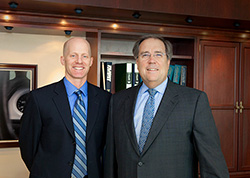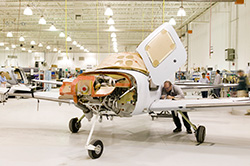 AOPA President Craig Fuller meets with Cirrus CEO Brent Wouters
AOPA President Craig Fuller meets with Cirrus CEO Brent Wouters
Few industries have been harder hit by the current economic downturn than aircraft manufacturers—and Cirrus Aircraft has made drastic changes to adjust to the new economic realities.
In a wide-ranging interview with AOPA editorial staff, Cirrus CEO Brent Wouters said the company based in Duluth, Minn., has moved aggressively to slash costs. At the same time, its high-profile Vision single-engine jet program is moving forward—and the distinctive V-tail jets are likely to be priced well above the $1 million mark that Cirrus long hinted was its target.
“It’s not going to be a $1 million jet,” said Wouters, formerly chief financial officer at Cirrus. “We’re going to price it realistically, and we don’t know what the final number is going to be—but well-equipped it will be well above the $1 million mark." We’re taking a pragmatic approach to the program, and that means we’re going to set a realistic price.”
Cirrus has collected more than 400 deposits of $100,000 each on the Vision, which first flew in July 2008.
Wouters said the five-seat airplane is meeting or exceeding its design goals. He estimates 80 percent of the SF50’s certification and production costs are still ahead.
“The aerodynamics have proven out in flight tests,” he said. “It’s on track and certifiable. But we’ve got a long way to go.”
Wouters said Cirrus has slashed ongoing costs by $55 million annually and drastically reduced employees (640 today from a peak of 1,350) to match a precipitous drop in demand. Deliveries of piston SR20 and SR22 aircraft fell from 710 in 2007 to 550 last year, and the company expects to produce about 320 this year.
Wouters said the privately owned firm can be profitable at those production rates, and Cirrus can ramp up quickly if demand returns.
“If demand comes back, we’ll be able to accommodate,” he said. “And we’re starting to see some favorable activity on the demand side.”
January was an awful month in terms of sales, he said, but February and March have shown steady improvement with about 42 new aircraft sold in March.
 “Minnesota is the place for us to be,” said CEO of Cirrus, Brent Wouters.
“Minnesota is the place for us to be,” said CEO of Cirrus, Brent Wouters.
Company managers will “relentlessly focus on costs,” he said, raise additional revenue through ongoing maintenance and service contracts, and look overseas for new fleet sales.
Wouters said Cirrus is extremely pleased with the quality, productivity, and cost of having its headquarters and manufacturing center in Minnesota, and the company has no intention of moving production overseas.
“Minnesota is the place for us to be,” he said.
Wouters said Cirrus will slow the pace of design changes to its core SR20 and SR22 aircraft now that a version of its SR22 will have FAA approval for flight into known icing conditions.
“We’ve got a great airplane,” he said. “Let’s simplify, focus, and stop changing it. The problem with rapid updates is that you don’t earn a return on your investment.”
Some Cirrus owners have criticized the company for introducing new models so quickly that the new airplanes make the existing aircraft obsolete and drive down their value.
Wouters said he is determined to take a disciplined approach to running the company and putting it on sound footing for long-term growth and stability.
“We’re going to build a healthy, sustainable company,” he said, “and that’s going to be good for everyone.”


